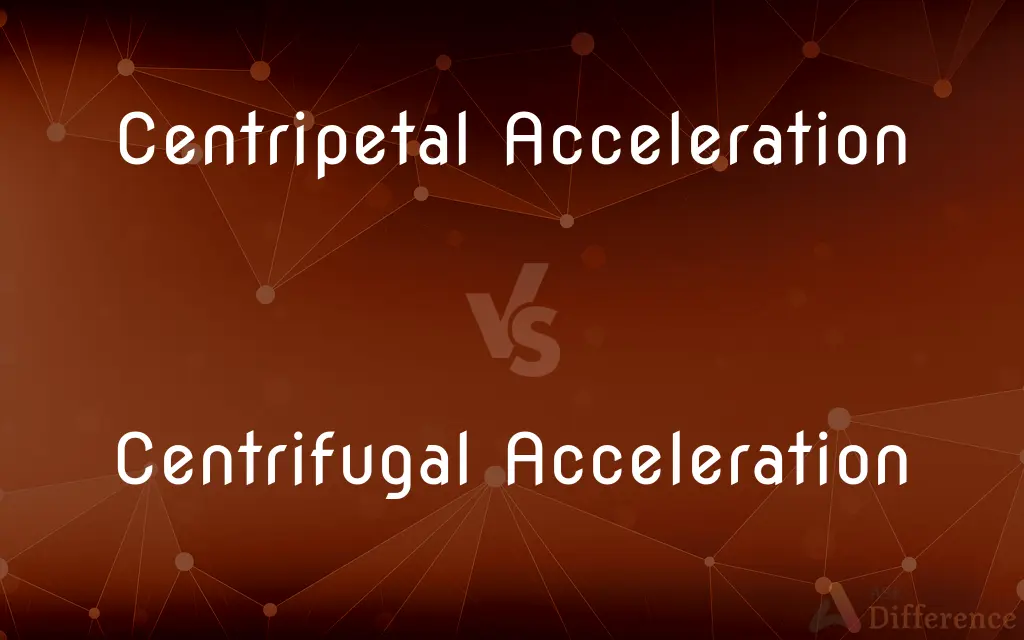Centripetal Acceleration vs. Centrifugal Acceleration — What's the Difference?
By Tayyaba Rehman — Published on January 14, 2024
Centripetal Acceleration is rate of change of tangential velocity of an object moving in a circular path, directed towards center of circle. Centrifugal Acceleration is a perceived force felt by an object moving in a circular path, directed outward.

Difference Between Centripetal Acceleration and Centrifugal Acceleration
Table of Contents
ADVERTISEMENT
Key Differences
Centripetal acceleration is always directed towards the center of the circular path and is necessary for an object to move in a circle. Centrifugal acceleration is an apparent acceleration felt in a rotating frame of reference, directed outward from the center of rotation.
Centripetal acceleration is a real force that acts on any object moving in a circular path. Centrifugal acceleration, on the other hand, is not a real force but an effect perceived in a rotating reference frame.
In a car taking a turn, the centripetal acceleration keeps the car on its curved path, while the passengers might feel a 'centrifugal force' pushing them outward, which is centrifugal acceleration.
Understanding centripetal acceleration is crucial in physics for analyzing circular motion dynamics. Centrifugal acceleration is important in understanding non-inertial frames of reference and the apparent forces acting in them.
Comparison Chart
Nature
Real force directed towards the center
Apparent force directed outward
ADVERTISEMENT
Physical Reality
Always present in circular motion
Felt only in rotating frames
Examples
Car turning, Moon orbiting Earth
Feeling pushed outward in a turning car
Importance
Crucial for analyzing circular motion
Understanding non-inertial frames
Compare with Definitions
Centripetal Acceleration
The rate of change of tangential velocity in circular motion.
In a roller coaster loop, the centripetal acceleration is what you feel as you're pressed into your seat.
Centrifugal Acceleration
Fictitious force in non-inertial reference frames.
The centrifugal acceleration is what causes water to stay in a bucket spun overhead.
Centripetal Acceleration
Acceleration that changes the direction of velocity, not its magnitude.
The centripetal acceleration of the spinning top maintains its circular path.
Centrifugal Acceleration
Perceived force in a circular motion, not a real force.
When turning sharply in a car, passengers experience the sensation of centrifugal acceleration.
Centripetal Acceleration
Acceleration towards the center of a circular path.
The centripetal acceleration keeps the moon in orbit around the Earth.
Centrifugal Acceleration
Outward acceleration felt by an object in a rotating system.
In a rotating space station, centrifugal acceleration can simulate gravity.
Centripetal Acceleration
Directed inward towards the axis of rotation.
In a washing machine, the centripetal acceleration acts on the clothes towards the center.
Centrifugal Acceleration
Opposite in direction to centripetal acceleration.
Centrifugal acceleration is the outward force you feel on a fast-spinning carnival ride.
Centripetal Acceleration
A necessary force for circular motion.
Without centripetal acceleration, the car would skid out of the turn.
Centrifugal Acceleration
An apparent force in a rotating frame, felt outward from the center.
On the merry-go-round, children feel centrifugal acceleration pushing them outward.
Common Curiosities
What is centrifugal acceleration?
Centrifugal acceleration is a perceived outward force experienced in a rotating frame of reference.
Can an object have both centripetal and centrifugal acceleration?
An object in circular motion has centripetal acceleration; centrifugal acceleration is only felt by observers in a rotating frame.
Where is centripetal acceleration directed?
Centripetal acceleration is always directed towards the center of the circular path.
What role does centripetal acceleration play in orbital motion?
It keeps celestial bodies, like satellites, in their circular or elliptical orbits.
Why is understanding centripetal acceleration important in physics?
It's crucial for analyzing dynamics in circular motion and understanding gravitational forces.
Does the magnitude of velocity change with centripetal acceleration?
Centripetal acceleration changes the direction of velocity, not its magnitude.
Is centrifugal acceleration a real force?
No, centrifugal acceleration is not a real force; it's a fictitious force perceived in rotating systems.
Why do we feel pushed outward in a turning car?
This feeling is due to centrifugal acceleration, an apparent force in a non-inertial frame.
What is centripetal acceleration?
Centripetal acceleration is the acceleration of an object moving in a circular path, directed towards the center.
How do centripetal and centrifugal acceleration relate in a rotating space station?
Centripetal acceleration keeps the station moving in a circle, while centrifugal acceleration provides an outward force simulating gravity.
How does centrifugal acceleration affect pilots?
Pilots must understand centrifugal acceleration to manage forces experienced during turns and maneuvers.
What happens when centripetal acceleration is removed?
Without centripetal acceleration, an object in circular motion would move off in a straight line due to inertia.
Is centrifugal acceleration used in designing rides?
Yes, it's considered in ride designs to understand the sensations riders will experience.
Can centrifugal acceleration be felt in a car going straight?
No, it's only experienced in rotating or turning frames, not in straight-line motion.
Share Your Discovery

Previous Comparison
Materialising vs. Materializing
Next Comparison
Mild Steel vs. Stainless SteelAuthor Spotlight
Written by
Tayyaba RehmanTayyaba Rehman is a distinguished writer, currently serving as a primary contributor to askdifference.com. As a researcher in semantics and etymology, Tayyaba's passion for the complexity of languages and their distinctions has found a perfect home on the platform. Tayyaba delves into the intricacies of language, distinguishing between commonly confused words and phrases, thereby providing clarity for readers worldwide.












































